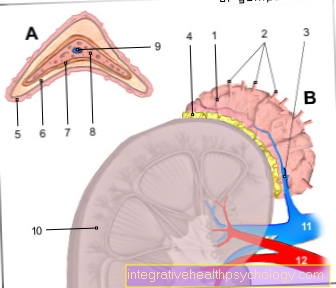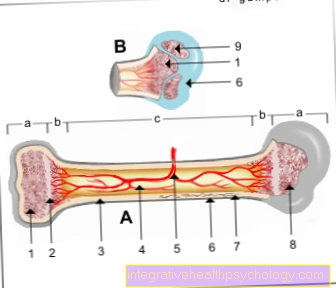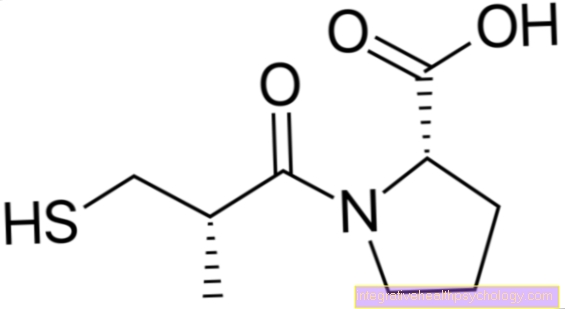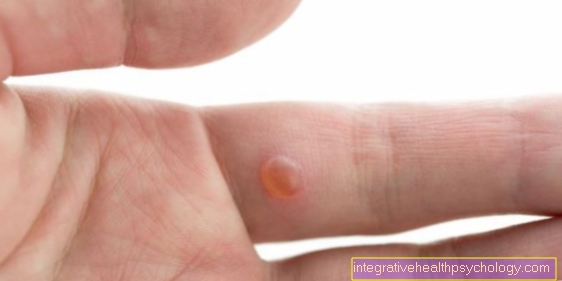Operation of a boil
Boils are unsightly and painful, but are usually good to treat. It is a purulent, bacterial-induced inflammation of hair follicles or sebum glands and the surrounding tissue. This means that boils can theoretically occur in any hairy area, but are most often found on the face, neck, armpits, in the pubic area or on the buttocks. The facial furuncles in the "warning triangle" around the nose are a special form that must be treated with great care. Improper treatment can lead to meningitis.
Read more on the subject at: boil

definition
„Ubi pus, ibi evacua“-“ Where there is pus, get it out! ”This is an old doctrine of medicine. But the operational opening of a boil is not always necessary. Partially boils empty spontaneously of their own accord, but can persist and lead to tender inflammation and, depending on the localization, even impair the function. In some cases, conservative treatment of the boil is also an option. However, this should always be clarified with a doctor.
In any case, the so-called Abscess splitting but can be done by a doctor. If the boil is not yet ripe and is expressed, it can dangerous infections up to blood poisoning. Often can through local Cooling and immobilization a success can be achieved. In the case of particularly large and severely inflamed follicles, the doctor can opt for an operation, i.e. an opening of the abscess. There are a few important points to consider.
The OP preparation
Before the operation, it is imperative to clarify whether the patient has been vaccinated against tetanus. If the last vaccination has passed and there is no longer adequate protection, the vaccination will be refreshed.
Read more on the topic: Tetanus vaccination
Before the actual operation, the patient is given a medication to relieve pain; local anesthesia by injecting local anesthetics is usually sufficient. This of course depends on the location and size of the boil. In the case of local anesthesia, it is not necessary to appear sober, of course you should avoid excessive amounts of food and fluids beforehand. With general anesthesia, the patient must abstain from food for at least 6 hours and abstain from clear liquids for 2 hours in order to minimize the risk of anesthesia.
Procedure of the operation
First, the area around the boil is generously coated several times with a disinfectant solution. This is an alcoholic solution and is intended to cleanse and disinfect the skin to prevent complications. The doctor will then cover the wound with a sterile cloth to further reduce the risk of infection. Now the boil is opened with a scalpel. The pus is sucked out. If an antibiotic is needed to prevent skin infection, a smear is taken to identify the pathogen. Sometimes it is necessary to remove necrotic, i.e. dead tissue, with a sharp spoon. After the pus has been completely emptied, the wound is carefully rinsed. Smaller bleeding is stopped with a so-called electrocautery. With larger boils, it may be necessary to insert a so-called drainage system that allows the pus to continue to drain. Sometimes sponges or platelets containing antibiotics are inserted to reduce the risk of infection.
Duration of the operation
The opening of the follicle is associated with a minimal incision and usually takes time not long. Hygiene measures such as disinfecting, rinsing and bandaging also take a minimum of time. Most straightforward boils are in under 45 minutes to operate.
Aftercare
After the operation, the wound is partially open for a day or two left open and flushed. Open boils can take a few weeks to completely heal. Regular Check-ups are important to make sure the surgical site has not become inflamed or refilled with pus. Treatment with antibiotics in tablet form may be necessary to reduce the risk of infections.
Operation Risks
Opening boils is a routine procedure, but like any operation, it is also associated with risks. Bleeding and secondary bleeding can occur and, depending on the extent of the tissue damage, scarring is possible. Wound healing disorders and recurring purulent inflammation are also rare, but possible. A special complication is the formation of fistulas, pathological connecting ducts to internal organs. This can always lead to an abscess. Allergic reactions can also occur. A serious but rare complication of the operation is blood poisoning, known in technical jargon as sepsis, in which bacterial pathogens enter the blood and cause fever and chills. The risk can be reduced by taking antibiotics.
Length of sick leave
How long the doctor writes the patient on sick leave after the procedure is very differently. It depends on the size, the location of the wound and the hygienic conditions at the workplace. A larger wound that is not initially covered for better healing must of course be treated with great care. Keeping the wound clean after the operation is a top priority.
Is an anesthetic necessary for a boil operation?
The inflamed skin is very sensitive to pain, so an anesthetic is required for such an operation. Depending on the location, it is usually done with a regional anesthetic. The doctor injects a so-called local anesthetic near the surgical site. The numbness may persist even after the procedure. It is therefore best to have someone pick you up and not operate a vehicle. If general anesthesia is required, an anesthetist must be present to monitor the patient's vital signs during the surgical rehabilitation. The patient is also under constant observation in the recovery room and is only discharged when complications from the anesthesia can be ruled out.
Outpatient or inpatient?
If the wound is to be cared for by the patient himself, hospitalization for follow-up treatment is not necessary. Nevertheless, one should go to the practice or the hospital after the procedure as far as possible leave with company. The most important thing is the prescribed hygienic measures strictly adhere to. Should a fever or chills set in, it is imperative to consult a doctor, as this can be life-threatening blood poisoning.





























